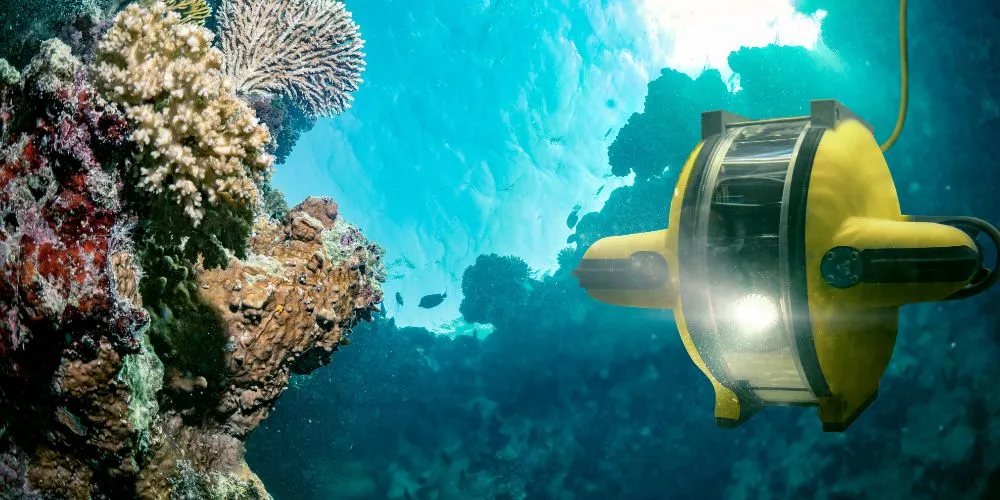Remotely Operated Vehicles (ROVs) have revolutionized the field of ocean exploration, enabling scientists and researchers to delve into the depths of the oceans with unprecedented precision and accuracy. This article explores the expansive realm of ROVs in oceanography, unveiling their significance, tracking the evolution of key technologies, examining diverse applications, and envisioning the transformative possibilities they hold for understanding Earth’s underwater landscapes.
The Significance of Remotely Operated Vehicles
Remotely Operated Vehicles play a pivotal role in ocean exploration by providing a remote and robotic means to navigate the depths where human divers may face limitations. The significance lies in their ability to capture high-resolution images, collect samples, and conduct experiments in environments that are often extreme, inaccessible, or hazardous for human exploration.
Precision Exploration in Extreme Environments
Remotely Operated Vehicles are equipped to explore extreme environments such as deep-sea hydrothermal vents, underwater volcanoes, and polar regions. These vehicles can withstand high pressures, extreme temperatures, and darkness, allowing scientists to study unique ecosystems and geological features that hold clues to the Earth’s history and the potential for extraterrestrial life.
High-Resolution Imaging and Data Collection
One of the key advantages of ROVs is their capability to capture high-resolution images and videos of the ocean floor. With advanced cameras and lighting systems, Remotely Operated Vehicles provide detailed visual documentation of underwater landscapes, marine life, and geological formations. Additionally, they can collect valuable data through sensors, contributing to ongoing research in oceanography.
Sampling and Experimentation at Depth
Remotely Operated Vehicles enable scientists to collect samples from the ocean floor, including sediments, rocks, and marine organisms. This capability is instrumental for understanding the composition of the seafloor, studying marine life, and conducting experiments in situ. ROVs equipped with specialized tools and manipulators can perform delicate tasks, such as retrieving samples or installing scientific instruments on the seafloor.
Evolution of Key Technologies in Remotely Operated Vehicles
The journey of ROVs is intricately woven with the evolution of key technologies that have continually expanded their capabilities and versatility.
Advanced Propulsion and Maneuverability
Modern Remotely Operated Vehicles are equipped with advanced propulsion systems that enhance their maneuverability and stability underwater. Thrusters and propellers allow precise movement control, enabling ROVs to navigate complex terrains, hover over specific locations, and conduct detailed inspections.
High-Resolution Imaging Systems
The evolution of imaging systems on ROVs has been remarkable. High-definition cameras, 3D imaging, and specialized sensors capture intricate details of the underwater environment. These imaging systems provide valuable scientific data and offer the public and researchers a glimpse into the mesmerizing world beneath the waves through live-streaming capabilities.
Improved Energy Efficiency and Endurance
Advancements in energy storage and management have extended ROVs’ endurance and operational capabilities. Lithium-ion batteries and efficient power systems allow ROVs to undertake longer missions, covering greater distances and spending more time exploring the ocean depths.
Manipulators and Sampling Tools
Remotely Operated Vehicles are equipped with manipulators and sampling tools that enable them to interact with the environment. These tools, such as robotic arms and grippers, facilitate the collection of samples, the installation of scientific instruments, and the execution of delicate tasks in challenging underwater conditions.
Diverse Applications of ROVs in Oceanography
Remotely Operated Vehicles have diverse applications across various sub-disciplines of oceanography, contributing to advancements in marine biology, geology, and environmental science.
Deep-Sea Biology and Biodiversity Studies
Remotely Operated Vehicles play a crucial role in deep-sea biology, allowing scientists to study unique ecosystems and discover new species in the ocean’s depths. By capturing high-resolution images and videos, ROVs contribute to biodiversity assessments and help unravel the mysteries of life in extreme environments.
Geological Surveys and Seafloor Mapping
ROVs are instrumental in conducting geological surveys and accurately mapping the seafloor. They can explore underwater features such as mountains, trenches, and canyons, providing valuable insights into Earth’s geological processes and history.
Archaeological Exploration and Underwater Cultural Heritage
ROVs are employed in archaeological exploration to investigate shipwrecks, submerged settlements, and underwater cultural heritage sites. By carefully documenting and preserving these sites, ROVs contribute to our understanding of human history and the impact of sea-level changes on coastal communities.
Environmental Monitoring and Pollution Assessment
ROVs are used for environmental monitoring and assessing the impact of human activities on the ocean ecosystem. They can collect water samples, measure water quality parameters, and document the effects of pollution, providing valuable data for conservation efforts and marine management.
Transformative Possibilities and Future Outlook
The trajectory of ROVs in ocean exploration points towards a future filled with continued innovation, integration, and unprecedented possibilities.
Deep-Sea Mining and Resource Exploration
As interest in deep-sea mining grows, ROVs will play a crucial role in resource exploration and extraction. These vehicles can navigate the depths to assess mineral deposits, collect samples, and provide valuable data for sustainable resource management.
Astrobiology and Extraterrestrial Exploration
ROVs designed for extreme underwater environments may find applications in astrobiology and extraterrestrial exploration. The technologies developed for deep-sea exploration can be adapted for missions to explore subsurface oceans on other planets, such as Europa and Enceladus.
Collaborative and Autonomous ROV Networks
The future of ROV exploration envisions collaborative networks of autonomous vehicles working together to explore large areas of the ocean. These networks, guided by artificial intelligence and machine learning, could optimize exploration efficiency, adapt to changing conditions, and conduct collaborative research on a global scale.
Conclusion
Remotely Operated Vehicles have ushered in a new era of precision and accessibility in ocean exploration. As we navigate the depths of the oceans with ROVs, the significance of these robotic explorers is both awe-inspiring and essential. With continued research, technological breakthroughs, and collaborative efforts, ROVs will remain a driving force in reshaping our understanding of the ocean’s mysteries, unlocking new possibilities, and contributing to the sustainable management of Earth’s underwater landscapes.























